Wandering the Worlds of C.S. Lewis, Part I: Boxen
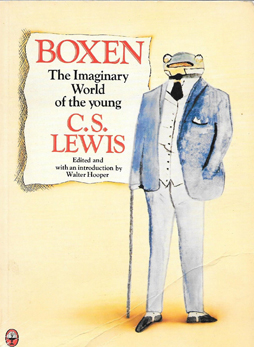 C.S. Lewis loved walking, and in one letter to his friend Arthur Greaves he wrote of a fifty-mile three-day expedition he undertook alongside other friends: walking by day through woods and river valleys, at evenings stopping at local houses where the company might discuss the nature of the Good. Bearing this image in mind I’ve decided to begin wandering through the terrain of Lewis’ fiction. It is well-trodden ground, as many others have done this before me. But there’s a certain charm in seeing things for oneself. It is also just possible that another pair of eyes may spot something new in even the most familiar landscape, if the terrain is varied enough. And Lewis’ writing, as a whole, stands out as heterogeneous indeed.
C.S. Lewis loved walking, and in one letter to his friend Arthur Greaves he wrote of a fifty-mile three-day expedition he undertook alongside other friends: walking by day through woods and river valleys, at evenings stopping at local houses where the company might discuss the nature of the Good. Bearing this image in mind I’ve decided to begin wandering through the terrain of Lewis’ fiction. It is well-trodden ground, as many others have done this before me. But there’s a certain charm in seeing things for oneself. It is also just possible that another pair of eyes may spot something new in even the most familiar landscape, if the terrain is varied enough. And Lewis’ writing, as a whole, stands out as heterogeneous indeed.
I have read some, though far from all, of Lewis’ non-fiction; I intend to talk about it only insofar as I see a bearing on his fiction. I’m interested in seeing what images, tones, ideas, and approaches unite a fairly disparate corpus of writing. I want to see how Lewis’ approach to storytelling developed over his life, and how motifs and themes recurred in his work. I hope that by doing this I’ll better understand his individual books. At any rate, I’ll begin here with a look at Lewis’ published juvenilia. Tomorrow I’ll have a look at his early collection of poetry, Spirits in Bondage, then the day after that his long poem Dymer. Next Sunday I’ll move on to his first long prose work, The Pilgrim’s Regress, and see what sort of schedule I can manage from there until I reach Lewis’ last novel, Till We Have Faces.
Note that these posts will be merely my own impression of Lewis’ work, rather than, say, an attempt to read Lewis by his own lights. So while Lewis believed that a writer’s biographical details were by and large irrelevant to their literary accomplishments, I’m a little more interested in how the story of a writer’s life maps onto the stories they choose to tell. Some chronological landmarks therefore follow by which to survey Lewis’ early writings.
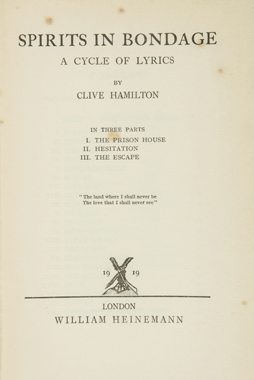 Born in 1898 in Ulster, as a child Lewis was inspired by books and the Irish countryside; the sight of the Castlereagh Hills inspired a kind of longing within him that he came to call ‘joy,’ a type of joy that would also be inspired by other sources — particularly certain kinds of poetry and myth. He later described his imagination being sparked at age six by a large, rambling house his father, a solicitor, had built for the family. By this point Lewis, perhaps inspired by the works of Beatrix Potter, had already begun writing stories about talking animals in a world of medieval chivalry. At the same time, Lewis’ older brother Warren was writing stories set in a fictional ‘India.’ Soon the brothers integrated their tales into a single world called ‘Boxen.’ Lewis would write stories based in this setting into his teens.
Born in 1898 in Ulster, as a child Lewis was inspired by books and the Irish countryside; the sight of the Castlereagh Hills inspired a kind of longing within him that he came to call ‘joy,’ a type of joy that would also be inspired by other sources — particularly certain kinds of poetry and myth. He later described his imagination being sparked at age six by a large, rambling house his father, a solicitor, had built for the family. By this point Lewis, perhaps inspired by the works of Beatrix Potter, had already begun writing stories about talking animals in a world of medieval chivalry. At the same time, Lewis’ older brother Warren was writing stories set in a fictional ‘India.’ Soon the brothers integrated their tales into a single world called ‘Boxen.’ Lewis would write stories based in this setting into his teens.
Lewis’ mother died of cancer when he was nine, and Lewis was sent to a school in England that was a nightmare of physical abuse and mentally stultifying exercises. After a year it closed because the headmaster was declared insane. Lewis was sent to another school, again in England; at age 13, having been raised an Anglican to that point, he became an atheist. He also became fascinated by Norse myth and Wagner, as well as Greek myth, and published his first poem in the school magazine. He graduated in 1913, spent a year at an English college where he was severely bullied (and during which he wrote a now-lost verse tragedy called Loki Bound), and ended up studying under a private tutor for two and a half years. At eighteen, with national conscription imminent, he was accepted to Oxford’s University College where he studied for a term before joining Oxford’s Officers’ Training Corps. He earned a commission, and, late in 1917, was sent to France to fight in the First World War.
After a bout of trench fever in February, 1918, Lewis was wounded by a shell which also killed his sergeant and army mentor; Lewis would carry a fragment of shrapnel in his chest the rest of his life, and by the time he had recovered from the wound the war was over. He returned to Oxford early in 1919, aiming at a degree in Literae Humaniores (roughly, humanities focussing on classical literature) and an eventual academic career. The same year, he published his first book, a collection of short lyric poetry called Spirits in Bondage.
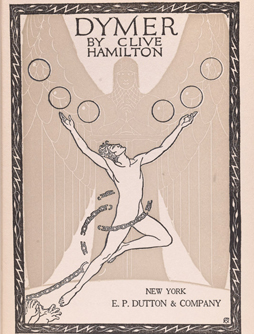 Lewis had become close friends with four other men while in the cadet corps; all were now dead, but he had also become close, and apparently romantically involved, with the mother of one of these men. Lewis began living with Jane King Moore (and her daughter Maureen) in 1921, and they’d stay together until Moore’s death in 1951. The early 1920s were mostly years of financial stress for Lewis, who was partially supported by his increasingly estranged father. Unable to get a job as a teacher, Lewis continued his schooling in English literature; in 1922 he also began writing a long narrative poem, Dymer, which was published in 1926. A year spent teaching undergraduate philosophy led in 1925 to a position at Oxford’s Magdalen College teaching English literature. Lewis was now financially secure in a profession he would follow most of the rest of his life, and after the death of his father in 1929, he and his brother sold their childhood home in Ireland. By this point he was already at work on a scholarly book about medieval allegory.
Lewis had become close friends with four other men while in the cadet corps; all were now dead, but he had also become close, and apparently romantically involved, with the mother of one of these men. Lewis began living with Jane King Moore (and her daughter Maureen) in 1921, and they’d stay together until Moore’s death in 1951. The early 1920s were mostly years of financial stress for Lewis, who was partially supported by his increasingly estranged father. Unable to get a job as a teacher, Lewis continued his schooling in English literature; in 1922 he also began writing a long narrative poem, Dymer, which was published in 1926. A year spent teaching undergraduate philosophy led in 1925 to a position at Oxford’s Magdalen College teaching English literature. Lewis was now financially secure in a profession he would follow most of the rest of his life, and after the death of his father in 1929, he and his brother sold their childhood home in Ireland. By this point he was already at work on a scholarly book about medieval allegory.
That’s more-or-less the first half of Lewis’ life, up to the point where he converted back to Christianity. It’ll be convenient to consider that when I look at The Pilgrim’s Regress. For the moment I want to discuss some of the surviving stories Lewis wrote in his youth, stories first published in 1985, well after Lewis’ death.
(I should note here that Lewis scholar Katherine Lindskoog has cast some doubt on the provenance of the surviving Boxen manuscripts and of some short stories that have emerged after Lewis’ death. I’m not personally convinced by her arguments, but I mention the point for the sake of completeness. The full details are in Lindskoog’s book The C.S. Lewis Hoax.)
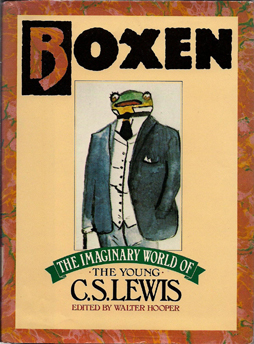 Boxen: The Imaginary World of the Young C.S. Lewis was edited by Walter Hooper, who was Lewis’ secretary at Lewis’ death. It collects a number of texts written by Lewis between (probably) age 7 and age 15, as well as a mock-academic “Encyclopedia Boxoniana” Lewis wrote in 1928 listing the “surviving documents” pertaining to Boxen. “The King’s Ring” is a comedy, complete with a list of dramatis personae. “Manx Against Manx” and “The King’s Ring” are brief fables with all the surreality a young child brings to story-telling. Two histories follow, the “History of Mouse-Land from Stone-Age to Bublish I” and “History of Animal-Land,” as well as “The Chess Monograph,” a fragment that starts to outline some of the background of the young Lewis’ imagined world. “The Geography of Animal-Land” is next, brief descriptions of places keyed to a map, not unlike a very simple role-playing game supplement. Three long ‘novels’ clearly written by a slightly older hand take up most of the book: “Boxen: or Scenes from Boxonian City Life,” “The Locked Door and Thank-Kyu,” and “The Sailor.” The whole thing’s interspersed with pictures and maps drawn by Lewis and his brother, and Hooper provides an introduction in which he mentions that other long ‘novels’ have survived — though as of 2015 they’ve yet to be published.
Boxen: The Imaginary World of the Young C.S. Lewis was edited by Walter Hooper, who was Lewis’ secretary at Lewis’ death. It collects a number of texts written by Lewis between (probably) age 7 and age 15, as well as a mock-academic “Encyclopedia Boxoniana” Lewis wrote in 1928 listing the “surviving documents” pertaining to Boxen. “The King’s Ring” is a comedy, complete with a list of dramatis personae. “Manx Against Manx” and “The King’s Ring” are brief fables with all the surreality a young child brings to story-telling. Two histories follow, the “History of Mouse-Land from Stone-Age to Bublish I” and “History of Animal-Land,” as well as “The Chess Monograph,” a fragment that starts to outline some of the background of the young Lewis’ imagined world. “The Geography of Animal-Land” is next, brief descriptions of places keyed to a map, not unlike a very simple role-playing game supplement. Three long ‘novels’ clearly written by a slightly older hand take up most of the book: “Boxen: or Scenes from Boxonian City Life,” “The Locked Door and Thank-Kyu,” and “The Sailor.” The whole thing’s interspersed with pictures and maps drawn by Lewis and his brother, and Hooper provides an introduction in which he mentions that other long ‘novels’ have survived — though as of 2015 they’ve yet to be published.
Boxen is an interesting example of a paracosm (a fictional world created by a child — in this case two children — and maintained over the course of years). There’s not much immediately apparent relevance to Lewis’ later writings, and Lewis himself downplayed the connection between Boxen and Narnia in particular. Still, it’s interesting to see how the growing depth of the fictions seems to echo some of Lewis’ later fascinations and techniques.
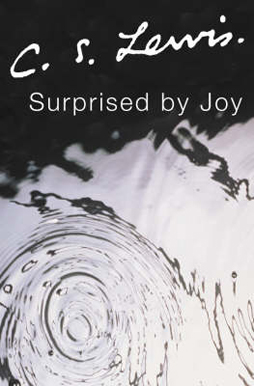 Reading through the book there is an odd sense of myth being retold and reinterpreted. The earliest stories by the young Lewis were based on his toys, and had a pseudo-medieval setting (apparently inspired by Arthur Conan Doyle’s novel Sir Nigel). When Animal-Land was united with the ‘India’ imagined by Lewis’ brother, Lewis was faced with a problem: ‘India’ was a modern country with modern technology, so — in the thinking of the brothers — the joint land of Boxen had to be modern as well. The Boxen stories took place centuries after Lewis’ original stories, leading to Lewis to try to write histories that would bridge the gap. Reading them in the order assembled in the published volume, you see the original short pieces becoming the foundation for the later historical superstructure: characters reinterpreted, events rationalised, narratives extended or questioned. In a sense there’s a tension here between myth and analysis.
Reading through the book there is an odd sense of myth being retold and reinterpreted. The earliest stories by the young Lewis were based on his toys, and had a pseudo-medieval setting (apparently inspired by Arthur Conan Doyle’s novel Sir Nigel). When Animal-Land was united with the ‘India’ imagined by Lewis’ brother, Lewis was faced with a problem: ‘India’ was a modern country with modern technology, so — in the thinking of the brothers — the joint land of Boxen had to be modern as well. The Boxen stories took place centuries after Lewis’ original stories, leading to Lewis to try to write histories that would bridge the gap. Reading them in the order assembled in the published volume, you see the original short pieces becoming the foundation for the later historical superstructure: characters reinterpreted, events rationalised, narratives extended or questioned. In a sense there’s a tension here between myth and analysis.
On the other hand, when Lewis looked back on the stories as an adult he tended to deprecate the creativity involved. In Surprised by Joy, a sort of spiritual autobiography published in 1955, Lewis described the Boxen tales as “prosaic.” Although he recalled being satisfied by his early “chivalric” stories, he felt the histories and longer novelistic stories derived from “the mood of the systematiser … the mood which led Trollope so endlessly to elaborate his Barsetshire.” Lewis wrote elsewhere that he enjoyed Trollope, but he’s criticising himself here for, essentially, excessive world-building. He felt that the Boxen and Animal-Land stories were training for “a novelist; not a poet.” There was, he wrote, a total lack of romance, and the stories were therefore not, in the highest sense, imaginative.
What did he mean by “romance”? Not love relationships; there aren’t any in the Boxen stories (and no major female characters, perhaps unsurprising for a world created by two young boys). “Romance” has several related meanings for Lewis, as I suspect I’ll discuss in a future post, but the relevant point here is his statement that “Animal-Land, by its whole quality, excluded the least hint of wonder.” This strikes me as a significant distinction. Poetry, romance, and wonder on one hand; the novelist and systematiser on the other.
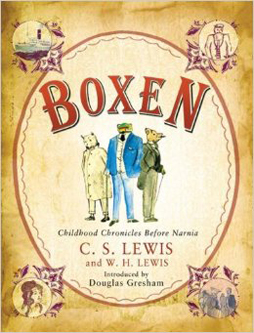 Certainly it seems as though the Boxen ‘novels’ are directly inspired by Lewis’ life in a way that would be unusual in his later work. Two of the main characters of the novels, the king of Animal-Land and the rajah of India, are dominated by their old teacher Big, a highly political frog, and Lewis himself has said that there’s a resemblance there to the Lewis brothers dominated by their politically-interested father. Both of the younger Lewises later recalled the adult visitors in their father’s home constantly talking politics, and recalled as well that political talk filtering into their stories; they saw “talking politics” as being something that adults did, for unguessable adult reasons. It is interesting to see Big at one point reminded by a sharp-tongued parliamentary opponent that he’s actually an alien to Boxen who comes from a “dependent island” called “Piscia, which is only a colony.” This provokes a long and outraged speech on the merits and history of Piscia, which I find oddly powerful; hard not to think that Lewis is writing about his Irishness, however transmogrified.
Certainly it seems as though the Boxen ‘novels’ are directly inspired by Lewis’ life in a way that would be unusual in his later work. Two of the main characters of the novels, the king of Animal-Land and the rajah of India, are dominated by their old teacher Big, a highly political frog, and Lewis himself has said that there’s a resemblance there to the Lewis brothers dominated by their politically-interested father. Both of the younger Lewises later recalled the adult visitors in their father’s home constantly talking politics, and recalled as well that political talk filtering into their stories; they saw “talking politics” as being something that adults did, for unguessable adult reasons. It is interesting to see Big at one point reminded by a sharp-tongued parliamentary opponent that he’s actually an alien to Boxen who comes from a “dependent island” called “Piscia, which is only a colony.” This provokes a long and outraged speech on the merits and history of Piscia, which I find oddly powerful; hard not to think that Lewis is writing about his Irishness, however transmogrified.
At any rate, there is a sense that Boxen is filled with things that the young Lewis half-understood along with images that caught his imagination. Politics and Prussian villains. Life aboard ship. Music-halls: one of the minor characters being the owner of a string of music-halls. In Surprised By Joy Lewis wrote that he had thought, when he was a child, that he enjoyed vaudeville but in fact later came to realise he enjoyed only the atmosphere of the show and the experience of the family excursion to the theatre. On the other hand, it’s interesting that the first surviving Animal-Land story is a brief stage comedy.
If the longer Boxen stories are novelistic, they at least use a range of novelistic techniques. There’s a certain complexity to the plots, well-chosen scene transitions, and multiple points of view. Description is relatively sporadic, with the narratives largely carried by dialogue but occasionally slowing for detailed scene-setting or character sketches. Above all, the stories build effectively. The first two describe a political upheaval in Boxen which leads, in the second story, to a brief war. The third describes an attempt to reform the morals of the Boxen navy by introducing an upstanding new sailor to a specific ship. The schemes are simplistic, but the sense of a narrative arc is strong.
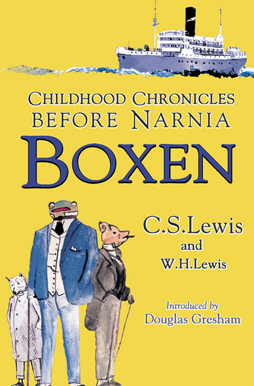 The notion of moral reform in the last story is interesting, precisely because it goes nowhere and is treated as idealistic buffoonery. There’s no sign of religion in the stories that I could see, which may be interesting given that they were presumably being written around the time that Lewis was losing his faith. There is in fact a certain sympathy for scoundrels; the music-hall owner’s a good man, while Big, the effective ruler of Boxen, is officous, bumptious, and occasionally violent. Big’s far from evil, but while he has good qualities, he’s also held up to mockery.
The notion of moral reform in the last story is interesting, precisely because it goes nowhere and is treated as idealistic buffoonery. There’s no sign of religion in the stories that I could see, which may be interesting given that they were presumably being written around the time that Lewis was losing his faith. There is in fact a certain sympathy for scoundrels; the music-hall owner’s a good man, while Big, the effective ruler of Boxen, is officous, bumptious, and occasionally violent. Big’s far from evil, but while he has good qualities, he’s also held up to mockery.
Most of the Boxen characters are notionally animals, but they act in completely human ways (“most;” one of the minor characters in the early stories, presumably based on one of Lewis’ toys, is a golliwog, which was essentially a doll based on a racial caricature). One character is a cat who joins the navy and, uncatlike, goes to sea, voluntarily bathes in the ocean, and once displays “almost superhuman energy.” Illustrations by Lewis show humans with animal-heads, like Egyptian gods in Victorian dress. Perhaps the humanness of the characters grew stronger as the stories became more novelistic. One of the early short stories has a mouse waking up to find his tail cut off, exactly the kind of awareness of an animal nature that the other stories are missing. The mouse, incidentally, is a knightly hero named Peter, and much as I don’t want to anticipate later work too much, I have to admit when one reads in another short story of Peter leading an army to victory there is an oddly familiar feel; perhaps for whatever reason the name struck a chord with Lewis.
Overall, as the published Boxen stories grow more sophisticated, they grow accordingly less fantastic and more directly concerned with everyday behaviour. This, more than anything else, is unlike what one might expect from Lewis’ later work. While readable, they’re most interesting because of the difference from Lewis’ adult fiction, not only in terms of craft but in terms of ambitions and interests. Move ahead several years, to Lewis’ first published poems, and things are different. More on that tomorrow.
Matthew David Surridge is the author of “The Word of Azrael,” from Black Gate 14. You can buy a collection of his essays for Black Gate, looking at some fantasy novels of the twenty-first century, here. You can find him on Facebook, or follow his Twitter account, Fell_Gard.
[…] “Wandering the Worlds of C.S. Lewis, Part I: Boxen” […]